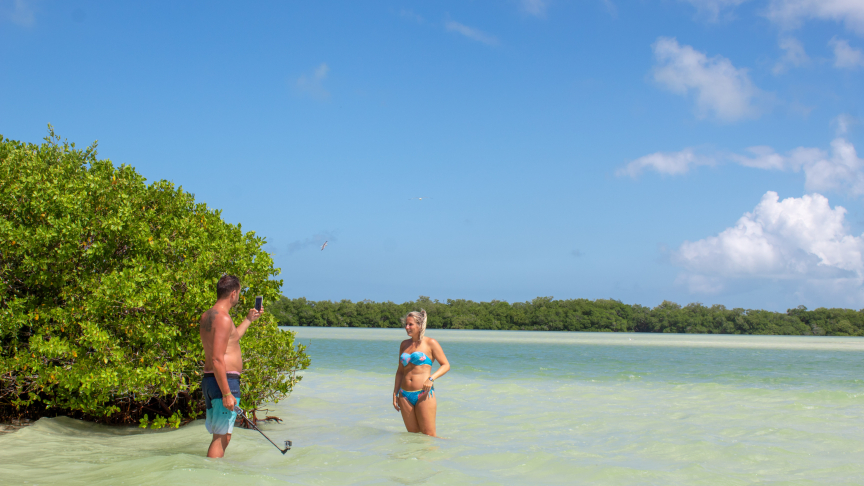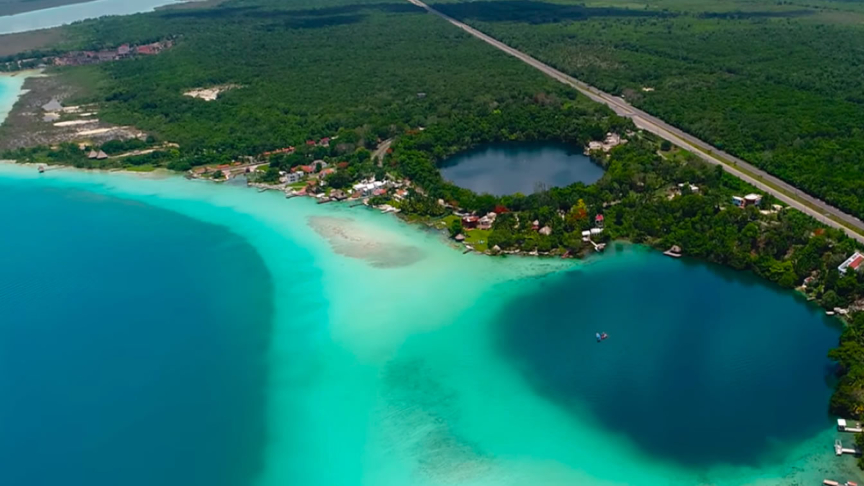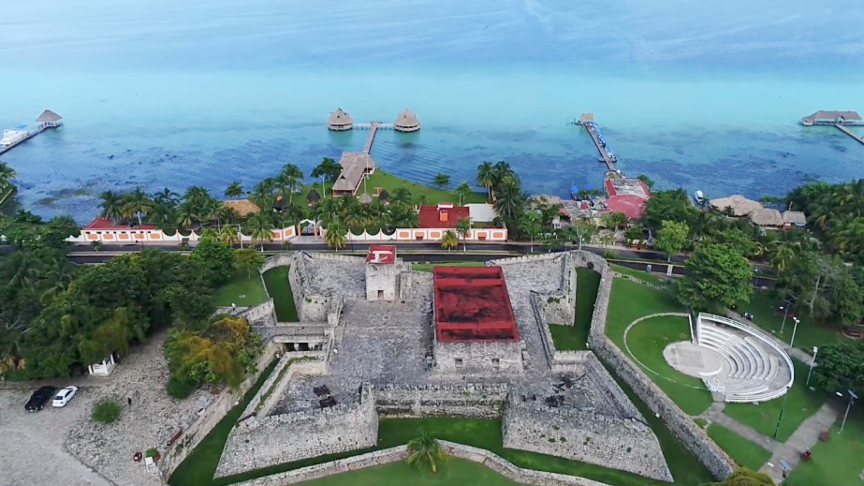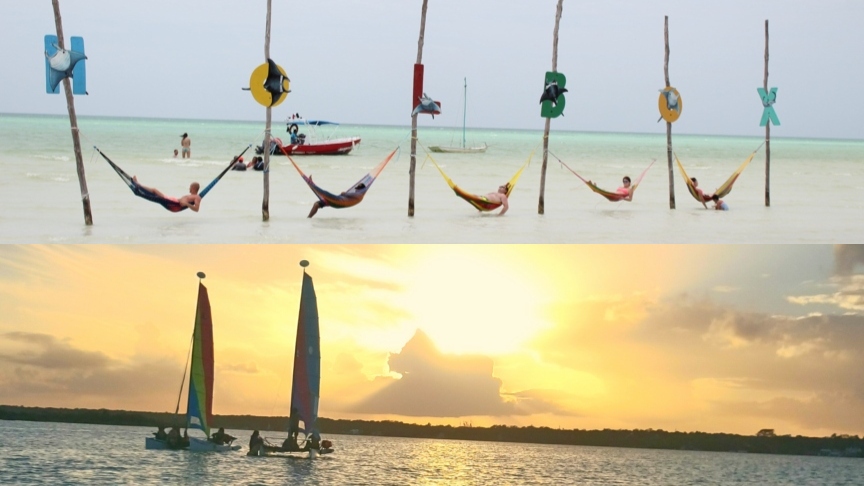Holbox or Bacalar
Holbox or Bacalar?
We are often asked the question and we often see it coming back in social networks: Which is better to visit now: Holbox or Bacalar? Both, of course, but you may not have time for that. That is why we decided to make a small comparison so that you can ultimately make your own choice.
The nice things about Holbox
Surrounded by waters in beautiful shades of green and turquoise due to its location in the Gulf of Mexico, the paradise island of Holbox is one of the most sought-after and popular among travelers. If you are looking for the ultimate relaxation you could spend a full week here, without the hustle and bustle of the city and without the big hotel chains. The island is ideal for enjoying the wide beaches and warm, shallow water, laid back atmosphere and the village feeling with cozy bars and restaurants and colorful street art. There is virtually no traffic: locals and tourists move around the island in golf carts that you can rent for a reasonable price per hour or per day.
Holbox is in our opinion one of the best places to visit if you want to disappear from the map for a while to forget all your worries and stress, and just relax and enjoy the beach.
What to do on Holbox?
You can book one of the many boat trips, where you visit different 'islands'. There is the Yalahau cenote, not really a cenote, but a freshwater source that is called 'ojo de agua' or 'water eye' in Spanish. You can see the crystal clear fresh water bubbling up from the underground river to the surface with your own eyes. A 30 minutes boat ride away is the 'bird island' where you can see various bird species in their natural habitat.

Our favorite is Isla Pasión, a small islet full of birds and iguanas just off the coast of Holbox. Here you wade through the shallow water and imagine yourself on Survivor. From the observation tower you have a beautiful view of Holbox and the surrounding waters in all shades of blue and green. With a bit of luck, a colony of flamingos will be fishing for plankton and small critters from the mud.
During the summer months, you can enjoy a stunning natural spectacle at night on Holbox: bioluminescence, the glowing of the sea. A type of plankton called phytoplankton emits light through a chemical reaction, creating blue or green glowing effects in the waves. The best chances of witnessing bioluminescence are when the sea is calm, between April and November, and when there's as little (natural) light as possible—so preferably around the new moon rather than the full moon. To experience this spectacle at its best, you can book a tour on the island, where a guide will take you out to sea in the middle of the night, either by boat or kayak.
One of the most well-known attractions on Holbox is swimming with the whale sharks, the largest and most impressive fish in the sea. Because of its enormous size, it might seem intimidating at first, but once you take your first dive into the water with them, you'll likely fall in love. However, we recommend doing this tour not from Holbox, but from Isla Mujeres. Most boats from Holbox go to the Gulf of Mexico, known as "the green water." This water is colder, and visibility is usually poor—you can see between 1 and 4 meters underwater. In contrast, boats from Isla Mujeres head to the Caribbean Sea, or "the blue water," which is warmer, deeper, and offers much better visibility—up to 25 meters. In recent years, hardly any whale sharks have been spotted in the Gulf of Mexico, which means boats from Holbox have had to travel 3 to 3.5 hours to reach the Caribbean zone anyway (from Isla Mujeres, it's usually 40 minutes to 1.5 hours). Another reason is that the boats from Holbox are generally of lower quality and much slower.
On the upside, the whale shark tour from Holbox often includes an extra snorkeling stop along the way and a chance to spot flamingos.
Lastly, a visit to Cabo Catoche is definitely worthwhile. It's the farthest point of the Yucatán Peninsula and can only be reached by boat. Here, you can see where the waters of the Gulf of Mexico and the Caribbean Sea meet. The area features breathtaking landscapes with untouched beaches. It’s the only place to snorkel near Holbox, and its shallow waters are full of marine life. You can see all kinds of fish and soft corals. Under rocks in the water, you might also find nurse sharks, octopuses, and lobsters. With a bit of luck, you might even spot dolphins during this tour.
For more activities on the island, check out The Holboxeño.
It also has its downsides
If you prefer Big Macs over tacos, or if you're a hipster glam backpacker, you can forget about your Starbucks tall pumpkin macchiato with almond milk, because you won’t find those kinds of chains on the island. The most luxurious vehicle you'll see is a 6-person golf cart, and occasionally a few trucks come to the island for construction or supplies. Other than that, dear traveler, you'll mostly have to get around on foot. But the island isn’t that big, and if you're a true backpacker at heart, walking a few meters is no big deal. For a good thigh workout, you can rent a bicycle and power your way through the sandy roads—an almost free workout.
Also important to know: there is very few ATMs on the island, and some only work occasionally, so make sure to bring enough cash with you for your stay. And for our influencers: cell service on the island is poor, and internet access is very limited. Now and then, you’ll have to go old school and hold your phone up in the air just to get a single bar. Of course, there are hotels and hostels with Wi-Fi—it’s not *that* far behind—but like the electricity supply, the signal comes and goes.
An island where you can’t do much more than relax might sound fun for a while, but many people soon get bored. And if you can’t even scroll through TikTok or Instagram because of the shaky internet, then it’s time to book an excursion. If you want to do touristy activities like visiting the ruins of Tulum or one of the New Seven Wonders of the World, Chichen Itzá—because after all, you're already in Mexico—be prepared for a long day. Your trip will likely need to start around 5 or 6 in the morning, with an early ferry crossing (which takes about 30 minutes), and then at least another 2.5 to 3 hours of travel. In short, you’re really far from everything.
But what do people complain about the most? Mosquitoes and seaweed. One of the things that makes Isla Holbox so beautiful is the abundance of greenery and mangroves that cover it. But this also means: lots of mosquitoes. The island is even nicknamed mosquito island. Unfortunately, it’s mosquito season all year round, but they’re worst from June to October. Be prepared to be attacked by these tiny creatures. They’re so small that locals call them “no-see-ums,” and they can sting badly—especially around sunset, between 5 and 7 p.m.
And then there’s the seaweed. This isn’t the same sargassum problem that sometimes affects the Riviera Maya, but rather a type of seagrass that washes ashore mainly in the winter months, from November to March, when there are northern winds. Unlike the Riviera Maya, this seagrass is not cleared away, because the island is part of a national park and this is considered a natural process. After a while, the seagrass begins to rot and smell, and of course the water becomes much less clear and less vibrant in color.
The nice things about Bacalar
In the south of the state of Quintana Roo, just half an hour from the border with Belize, lies Bacalar. This small village sits on one of the most impressive lagoons in Mexico: La Laguna de los Siete Colores, or the Lagoon of Seven Colors. Don’t let your imagination run wild—you're not going to see red, purple, or orange water. Instead, it's a stunning mix of shades of blue, turquoise, and green. Almost everyone who visits this beautiful spot is amazed by the breathtaking colors of the water.

Bacalar is truly a must-visit if you’re exploring the southern part of Quintana Roo or passing through on your way to Belize. Thanks to its beautiful natural surroundings and a totally unique charm that can’t be compared to the well-known beach destinations, Bacalar is absolutely worth a stop if you want to experience a different side of the Riviera Maya and its surroundings—without being constantly surrounded by crowds of tourists.
What to do in Bacalar?
The main activities in Bacalar all revolve around the beautiful lagoon. You can spend an afternoon sailing across the water (tip: go in the late afternoon so you can catch the beautiful sunset). We love and recommend Sailing Maya Adventours for well organized private sailing trips. You can also enjoy an impressive sunrise from a kayak or paddleboard, or simply relax with a drink on a terrace at one of the waterfront restaurants.

If you're interested in history, you can learn a bit by visiting the Fort of San Felipe de Bacalar. he fort was built in 1725 to protect the Maya community of Bacalar from constant attacks by English, French, and yes, even Dutch pirates. Later, in 1858, the fort was taken by the Maya during the Caste War, the Mexican civil war between the indigenous population and the elite of Spanish-descended Mexicans. At the museum, you can see weapons, cannons, maps, and a collection of Maya and colonial archaeological artifacts.
Another major attraction in Bacalar is the Cenote Azul, famous for its crystal-clear water, allowing visibility up to around 30 meters deep.
Something truly unique, which can only be seen in a few places around the world, are stromatolites—ancient living limestone formations. These structures are created when cyanobacteria trap and bind sediment while producing oxygen. They are among the oldest fossils on Earth, with some estimated to be about 3.5 billion years old. You could compare stromatolites to coral, but they only form in very specific environments, particularly in highly alkaline waters like Bacalar's lagoon. Along the edge of the lagoon lies a vast formation of living, giant stromatolites, stretching over 10 kilometers in length. As far as we know, these are the largest living organisms on Earth.
The Lagoon of Xul-Ha, with its turquoise waters, is a hidden gem in the southern part of the Bacalar Lagoon, located just over 15 minutes by car from the village. "Xul-Ha" means "where the water ends" in Maya.
Los Rápidos de Bacalar (the Bacalar Rapids) is actually the name of a restaurant. It sits right next to the channel that separates the Bacalar Lagoon from the Xul-Ha Lagoon. A constant flow of water runs through this narrow passage between the two lagoons, creating a current that can be quite strong depending on the season. The best thing to do is walk to the start of the stream and get into the water there. Once in the water, you simply lift your feet and let the current carry you along. You can also rent a kayak to float through the stream, but be careful not to damage the fragile stromatolites along the way.
It also has its downsides
Aside from the lagoon and the fort, there really isn’t that much to do in Bacalar. If you want to disconnect from the world a little—without going completely off the grid—Bacalar is a good option. But as soon as you’re looking for more activities, you’ll quickly need to travel further.
The Bacalar Lagoon is highly alkaline and has very little underwater life—don’t expect to see fish, for example. So, diving isn’t possible. You can snorkel, but you’ll mostly just see sand. If you’re interested in diving, we recommend traveling to Mahahual, which is about an hour and a half from Bacalar.
There’s no beach. As you've probably gathered by now, Bacalar is located on an inland lagoon, not by the sea. There are some grassy areas, but most of these are privately owned and belong to hotels, restaurants, or private homes.
The lagoon and Bacalar area are really only enjoyable when the weather is good—when the sun is shining and the sky is mostly clear. We once visited during two straight days of rain, and honestly, there wasn’t much to do. You couldn’t even see the lagoon’s famous colors.
If you're looking for a bit more of a city atmosphere, you could visit Chetumal, the capital of Quintana Roo—but it's not really recommended. It’s not a beautiful city, and there isn’t much to see or do.
On top of that, everything is fairly far away and public transportation isn’t always reliable.
Over the past years, the Bacalar Lagoon has been under environmental threats. A few years ago, the lagoon lost its beautiful colors. The water turned greenish, and at one point it even turned completely brown. The causes include intensive agriculture and the use of pesticides and chemicals, deforestation for large construction projects such as the dreaded Tren Maya, the construction of hotels and housing, excessive tourism, and the most recent hurricane season, which hit the area with two hurricanes. A combination of all these factors is what damaged the lagoon—and it's uncertain how long the lagoon will remain its clear water and stunning colors.
So, which one should you visit?
Like most things in life, both places have their pros and cons. Ideally, you should visit both Holbox and Bacalar. They are both pueblos mágicos—designated as magical towns by the Mexican government. Each has its own laid-back vibe and has not yet been completely overrun by tourists, although that may not last much longer, especially in these Instagram-driven times.
It really depends on your personal preferences and what you're looking for—what suits you best and what fits more easily into your travel itinerary. We hope this comparison has helped you make your choice. Whichever destination you end up picking, we’re sure you’ll enjoy it just as much as we did when we visited. And if you just want to visit Holbox for a day, you can always join us on an excursion.
Have you ever been to Holbox or Bacalar? Which one did you like better? Got any good tips? Feel free to share them in the comments!
For more beautiful spots and adventures in the Riviera Maya you can follow us on our social media: Instagram, Facebook, and Youtube.




0 Comments